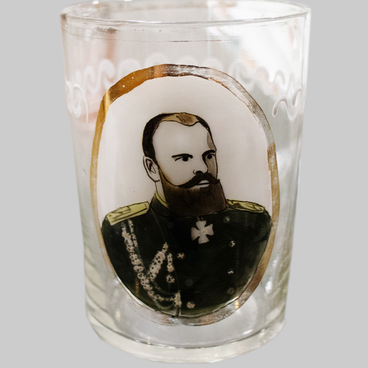Dmitrovsky was the first private porcelain factory in Russia. The factory was founded by the Russified Englishman Francis (Franz) Gardner in the village of Verbilki in 1766.
For seven years, Gardner’s factory was solely managed by Pavel Petrovich Gardner (1828–1869), a descendant of the original owners. He was a tough manager, but thanks to his good artistic taste, he was able to identify and skillfully use development trends in the culture and the democratic movement, which saw a revival in the 1860s.
At an 1870 exhibition, products of the factory received a well-deserved award. In 1872, the plant was awarded another honorary badge of the Russian Empire. In those days, there was a special focus on boosting faience production, which required fewer costs and ensured a bigger market. Our exhibit is also made of faience.
The main decoration method was decal printing and finishing hand-painting with colored pigments.
A Chinese theme in chinoiserie style on the dish bottom was a common design. Chinoiserie (a French word) refers to the use of stylistic devices of medieval Chinese art. The genre is widespread in European painting, crafts, fashion, and garden landscaping in the 18th century.
The emergence of this stylized design genre was inspired by the fascination with Chinese porcelain, which swept aristocratic Europe at the end of the 17th century. On the back of this fascination, interest in the Chinese artistic tradition picked up. This interest, however, was utterly superficial: without getting into Eastern philosophy, into the deep meaning of ancient art, into the symbolism of its elements.
Europeans knew very little about China, so the 18th-century craftsmen had to conjecture and fantasize based on their own idea of it.
As for the exhibit in question, in the center of the dish there is a stylized image of a Chinese peony branch, with two pheasants perched on it. Surrounding them, are fantastic flowers, leaves and fruits. The edges are decorated with an ornament. Such themes are usually said to depict birds of paradise and flowers.
While the picture was printed, it does not give the impression of being a print. A subtle hand-painting covers the entire bottom of the dish, running over the print. This way, the work of the artist comes to the fore and gives the impression of highly artistic hand-crafted work. On the back side of the dish, there is a depressed image of the Moscow city emblem, and the inscription: “Gardner Factory in Moscow.” This is not related to the location of the factory, but a confirmation of its government status.
For seven years, Gardner’s factory was solely managed by Pavel Petrovich Gardner (1828–1869), a descendant of the original owners. He was a tough manager, but thanks to his good artistic taste, he was able to identify and skillfully use development trends in the culture and the democratic movement, which saw a revival in the 1860s.
At an 1870 exhibition, products of the factory received a well-deserved award. In 1872, the plant was awarded another honorary badge of the Russian Empire. In those days, there was a special focus on boosting faience production, which required fewer costs and ensured a bigger market. Our exhibit is also made of faience.
The main decoration method was decal printing and finishing hand-painting with colored pigments.
A Chinese theme in chinoiserie style on the dish bottom was a common design. Chinoiserie (a French word) refers to the use of stylistic devices of medieval Chinese art. The genre is widespread in European painting, crafts, fashion, and garden landscaping in the 18th century.
The emergence of this stylized design genre was inspired by the fascination with Chinese porcelain, which swept aristocratic Europe at the end of the 17th century. On the back of this fascination, interest in the Chinese artistic tradition picked up. This interest, however, was utterly superficial: without getting into Eastern philosophy, into the deep meaning of ancient art, into the symbolism of its elements.
Europeans knew very little about China, so the 18th-century craftsmen had to conjecture and fantasize based on their own idea of it.
As for the exhibit in question, in the center of the dish there is a stylized image of a Chinese peony branch, with two pheasants perched on it. Surrounding them, are fantastic flowers, leaves and fruits. The edges are decorated with an ornament. Such themes are usually said to depict birds of paradise and flowers.
While the picture was printed, it does not give the impression of being a print. A subtle hand-painting covers the entire bottom of the dish, running over the print. This way, the work of the artist comes to the fore and gives the impression of highly artistic hand-crafted work. On the back side of the dish, there is a depressed image of the Moscow city emblem, and the inscription: “Gardner Factory in Moscow.” This is not related to the location of the factory, but a confirmation of its government status.



